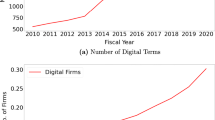Abstract
This paper shows how specific technological and relational regimes have shaped the growth of the network of R&D collaborative agreements in pharmaceuticals in the 1990s. Our analysis reveals the existence of a complex set of regimes of firm growth within the network, providing additional evidence supporting prediction that both growth and innovative activities of large and small firms respond, even within a given industry, to considerably different technological and economic factors. Moreover, the paper shows, in the context of a specific industry and by means of a series of preliminary and explorative empirical analyses, that information on the topological properties of a given industrial settings and on roles/positions of organizations within it can be used to disentangle some fundamental generative processes underlying observed processes of growth. This result contributes to the "old" stochastic approach to firm growth, in the direction of building parsimonious and, at the same time, more realistic, representations of processes of industrial growth.
Similar content being viewed by others
References
Acs, Z. and D. B. Audretsch, 1988, 'Innovation in Large and Small Firms: An Empirical Analysis', American Economic Review 78(4), 678–690.
Ando, A. and F. M. Fisher, 1963, 'Near-Decomposability, Partition and Aggregation, and the Relevance of Stability Discussions', International Economics Review 4, 53–67.
Arora, A., A. Fosfuri and A. Gambardella, 2001, Markets for Technology, Cambridge, MA: MIT Press.
Arrow, K. J., 1983, 'Innovation in Large and Small Firms', in J. Ronen (ed.), Entrepreneurship, Lexington, MA: Lexington Books, pp. 15–28.
Asratian, A. S., T. M. J. Denley and R. Haggkvist, 1998, Bipartite Graphs and Their Applications, Cambridge: Cambridge University Press.
Audretsch, D. B., 1995, Innovation and Industry Evolution, Cambridge: MIT Press.
Diersel, R., 1997, Graph Theory, Berlin: Springer-Verlag.
Dosi, G., 1982, 'Technological Paradigms and Technological Trajectories. A Suggested Interpretation of the Determinants and Directions of Technical Change', Research Policy 11, 147–162.
Dosi, G., O. Marsili, L. Orsenigo and R. Salvatore, 1995, 'Learning, Market Selection and the Evolution of Industrial Structures', Small Business Economics 7, 411–436.
Dulmage, A. L. and N. S. Mendelsohn, 1967, 'Graphs and Matrices', in F. Harary (ed.), Graph Theory and Theoretical Physics, London: Academic Press.
Friedman, J. H., 1984, A Cariable Apan Smoother, Tech. Rep. No. 5, Laboratory for Computational Statistics, Department of Statistics, Stanford University, CA.
Harary, F., R. Z. Norman and D. Cartwright, 1975, Structural Models: An Introduction to the Theory of Directed Graphs, New York: John Wiley & Sons.
Ijiri, Y. and H. A. Simon, 1977, Skew Distributions and the Sizes of Business Firms, Amsterdam: North Holland.
Lovasz, L. and M. D. Plummer, 1986, Matching Theory. Annals of Discrete Mathematics, vol. 29, Amsterdam: North Holland.
Nelson, R. R. and S. G. Winter, 1982, An Evolutionary Theory of Economic Change, Cambridge, MA: Harvard University Press.
Orsenigo, L., F. Pammolli and M. Riccaboni, 2001, 'Technological Change and Network Dynamics. Lessons from Pharmaceuticals', Research Policy 30, 485–508.
Powell, W. W., K. Koput and L. Smith-Doerr, 1996, 'Technological Change and the Locus of Innovation: Networks of Learning in Biotechnology', Administrative Science Quarterly 44(1), 116–145.
Riccaboni, M., 2000, 'Network Evolution in Drug Discovery', Ph.D. dissertation, Sant'Anna School of Advanced Studies, Pisa.
Riccaboni, M. and F. Pammolli, 2001, 'Technological Regimes and the Growth of Networks: A Simulative Model', Presented at the 8th Schumpeterian Society, Manchester.
Simon, H. A., 1962, 'The Architecture of Complexity', Proceedings of the American Philosophical Society 106, 467–482.
Simon, H. A., 1991, 'Organizations and Markets', Journal of Economic Perspectives 5, 25–44.
Winter, S. J., 1984, 'Schumpeterian Competition in Alternative Technological Regimes', Journal of Economic Behavior and Organization 5, 287–320.
Author information
Authors and Affiliations
Rights and permissions
About this article
Cite this article
Pammolli, F., Riccaboni, M. Technological Regimes and the Growth of Networks: An Empirical Analysis. Small Business Economics 19, 205–215 (2002). https://doi.org/10.1023/A:1019682612073
Issue Date:
DOI: https://doi.org/10.1023/A:1019682612073




